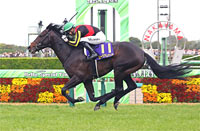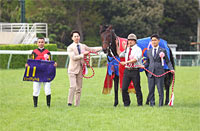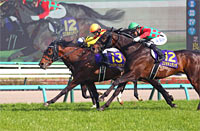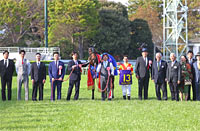Satsuki Sho (Japanese 2000 Guineas) (G1) - Data Analysis
First leg of classic Triple Crown
The Satsuki Sho (Japanese 2000 Guineas) was won by Saturnalia in 2019 and by Contrail in 2020. Both runners entered the race backed as the race favorite and achieved their fourth consecutive victory in the race with an unbeaten record as expected. However, runners backed as race favorite struggled from 2011 to 2018, producing only one winner. Because the Satsuki Sho brings together three-year-olds that still have a lot of fight in them, it is not uncommon for strong yet poorly favored runners to snatch the spoils. Let’s now analyze some trends in this race based on results over the last 10 years, including the 2011 race held at Tokyo Racecourse.
Runners with three to five career starts perform well
Many strong performers had previously followed a relaxed racing schedule, entering only a small number of races after having contested their debut race in the summer or fall of the previous year. As shown in the table below, we should concentrate bets on runners with three to five career starts, which dominated the Top 3 in the six consecutive years since 2015. In contrast, the last runner to enter the Satsuki Sho with six or more career starts and win the race was 2013 winner Logotype, while runners with two or fewer career starts produced zero Top 3 finishers. When planning bets, we should focus on runners with three to five career starts. [Table 1]
[Table 1] Performance by total career starts (last 10 years)
| Total career starts |
Performance
[1st-2nd-3rd-4th or lower] |
Win ratio |
Top 2 ratio |
Top 3 ratio |
| 2 or fewer |
0-0-0-5 |
0% |
0% |
0% |
| 3 |
2-3-3-16 |
8.3% |
20.8% |
33.3% |
| 4 |
4-3-4-35 |
8.7% |
15.2% |
23.9% |
| 5 |
2-4-2-35 |
4.7% |
14.0% |
18.6% |
| 6 or more |
2-0-1-54 |
3.5% |
3.5% |
5.3% |
Runners with three or more victories in JRA races have the edge
The 175 runners that entered the Satsuki Sho over the last 10 years had each notched one to four wins in previous JRA races. Runners with four victories achieved the highest success ratios, followed by runners with three wins. A large number of runners with two victories also did well, but there were few examples of strong performance among runners with only one victory. In addition, runners with three or more victories, some of which achieved in graded races, delivered performance of [6-7-5-34] (Top 2 ratio of 25.0%, Top 3 ratio of 34.6%), which are statistics that inspire confidence. [Table 2]
[Table 2] Performance by number of wins in JRA races (last 10 years)
| Number of wins |
Performance
[1st-2nd-3rd-4th or lower] |
Win ratio |
Top 2 ratio |
Top 3 ratio |
| 4 |
2-1-0-2 |
40.0% |
60.0% |
60.0% |
| 3 |
4-7-5-42 |
6.9% |
19.0% |
27.6% |
| 2 |
4-2-4-68 |
5.1% |
7.7% |
12.8% |
| 1 |
0-0-1-33 |
0% |
0% |
2.9% |
Success in newcomer races preferable
Looking at performances in JRA newcomer races over the last 10 years, we find that runners that had won such a race dominated the Top 3 in the last two years. This suggests that runners in this category are likely to deliver strong success ratios. [Table 3]
[Table 3] Performance by finish in newcomer race (last 10 years)
| Finish |
Performance
[1st-2nd-3rd-4th or lower] |
Win ratio |
Top 2 ratio |
Top 3 ratio |
| 1st |
7-8-9-63 |
8.0% |
17.2% |
27.6% |
| 2nd or lower |
3-2-1-79 |
3.5% |
5.9% |
7.1% |
In addition, the distance of the newcomer race in which the victory was secured also seems to affect performance. Runners that had won a 1,600m newcomer race delivered excellent performance. Among such runners, the group that had won a 1,600m newcomer race in June of the previous year produced outstanding performers such as 2020 runner-up Salios, 2019 winner Saturnalia, and 2014 winner Isla Bonita. However, among runners that had previously won a newcomer race with a distance of 2,000m (same as Satsuki Sho), performance was surprisingly sluggish, which is an interesting fact. [Table 4]
[Table 4] Among runners that had won a newcomer race, performance by distance of that race (last 10 years)
| Distance |
Performance
[1st-2nd-3rd-4th or lower] |
Win ratio |
Top 2 ratio |
Top 3 ratio |
| Below 1600m |
1-0-0-8 |
11.1% |
11.1% |
11.1% |
| 1600m |
4-1-2-10 |
23.5% |
29.4% |
41.2% |
| 1800m |
2-7-5-27 |
4.9% |
22.0% |
34.1% |
| 2000m |
0-0-2-18 |
0% |
0% |
10.0% |
Runners coming from Hopeful Stakes or Kyodo News Hai (Tokinominoru Kinen) have fared well in recent years
Looking at performances by previous race, we find that runners that had contested the Hopeful Stakes in their previous race and moved on to the Satsuki Sho after an intervening rest period, won the race in the last two years (Saturnalia in 2019 and Contrail in 2020). This year, we should again pay attention to runners coming straight from the Hopeful stakes. In addition, runners that had contested the Kyodo News Hai (Tokinominoru Kinen) as a lead-up race to the Satsuki Sho performed well, delivering four winners in the five years from 2012 to 2016. Surprisingly, runners coming from the Hochi Hai Yayoi Sho (Japanese 2000 Guineas Trial), which is contested at the same racecourse as the Satsuki Sho and has produced many Satsuki Sho winners in the past, achieved zero wins over the last 10 years. [Table 5]
[Table 5] Performance by previous race (last 10 years)
| Previous race |
Performance
[1st-2nd-3rd-4th or lower] |
Win ratio |
Top 2 ratio |
Top 3 ratio |
Kyodo News Hai
(Tokinominoru Kinen) |
4-0-2-10 |
25.0% |
25.0% |
37.5% |
| Spring Stakes |
3-1-3-32 |
7.7% |
10.3% |
17.9% |
| Hopeful Stakes |
2-0-0-1 |
66.7% |
66.7% |
66.7% |
| Mainichi Hai |
1-0-0-9 |
10.0% |
10.0% |
10.0% |
Hochi Hai Yayoi Sho
(Japanese 2000 Guineas Trial) |
0-5-2-34 |
0% |
12.2% |
17.1% |
| Wakaba Stakes |
0-2-1-21 |
0% |
8.3% |
12.5% |
| Arlington Cup |
0-1-0-2 |
0% |
33.3% |
33.3% |
| Asahi Hai Futurity Stakes |
0-1-0-0 |
0% |
100% |
100% |
| Sumire Stakes |
0-0-0-11 |
0% |
0% |
0% |
| Other race |
0-0-2-26 |
0% |
0% |
7.1% |
Note: Data for Hopeful Stakes includes years during which the race was held as a G2 race (before the upgrade to G1 status).
Seek out the winner!
Winners have either won a G1 race in their last outing, or achieved a Top 2 finish in a graded race held in February-March last time out
The last 10 winners had either achieved a Top 2 finish in a turf 1,800-2,000m graded race in February-March last time out, or won the Hopeful Stakes (G1) at the end of the previous year in their last outing. Incidentally, this trend holds true for the 12 years since 2009. Runners that had contested a non-graded race last time out or been beaten to 3rd or lower in their previous race have delivered runners-up and third-place finishers, but have struggled to produce a winner. [Table 6]
[Table 6] Winners’ previous race and finish (last 10 years)
| Year |
Winner |
Previous race |
| 2011 |
Orfevre |
March |
Spring Stakes |
1st |
| 2012 |
Gold Ship |
February |
Kyodo News Hai (Tokinominoru Kinen) |
1st |
| 2013 |
Logotype |
March |
Spring Stakes |
1st |
| 2014 |
Isla Bonita |
February |
Kyodo News Hai (Tokinominoru Kinen) |
1st |
| 2015 |
Duramente |
February |
Kyodo News Hai (Tokinominoru Kinen) |
2nd |
| 2016 |
Dee Majesty |
February |
Kyodo News Hai (Tokinominoru Kinen) |
1st |
| 2017 |
Al Ain |
March |
Mainichi Hai |
1st |
| 2018 |
Epoca d’Oro |
March |
Spring Stakes |
2nd |
| 2019 |
Saturnalia |
December |
Hopeful Stakes |
1st |
| 2020 |
Contrail |
December |
Hopeful Stakes |
1st |
(Yodohito Himezono)
|




















